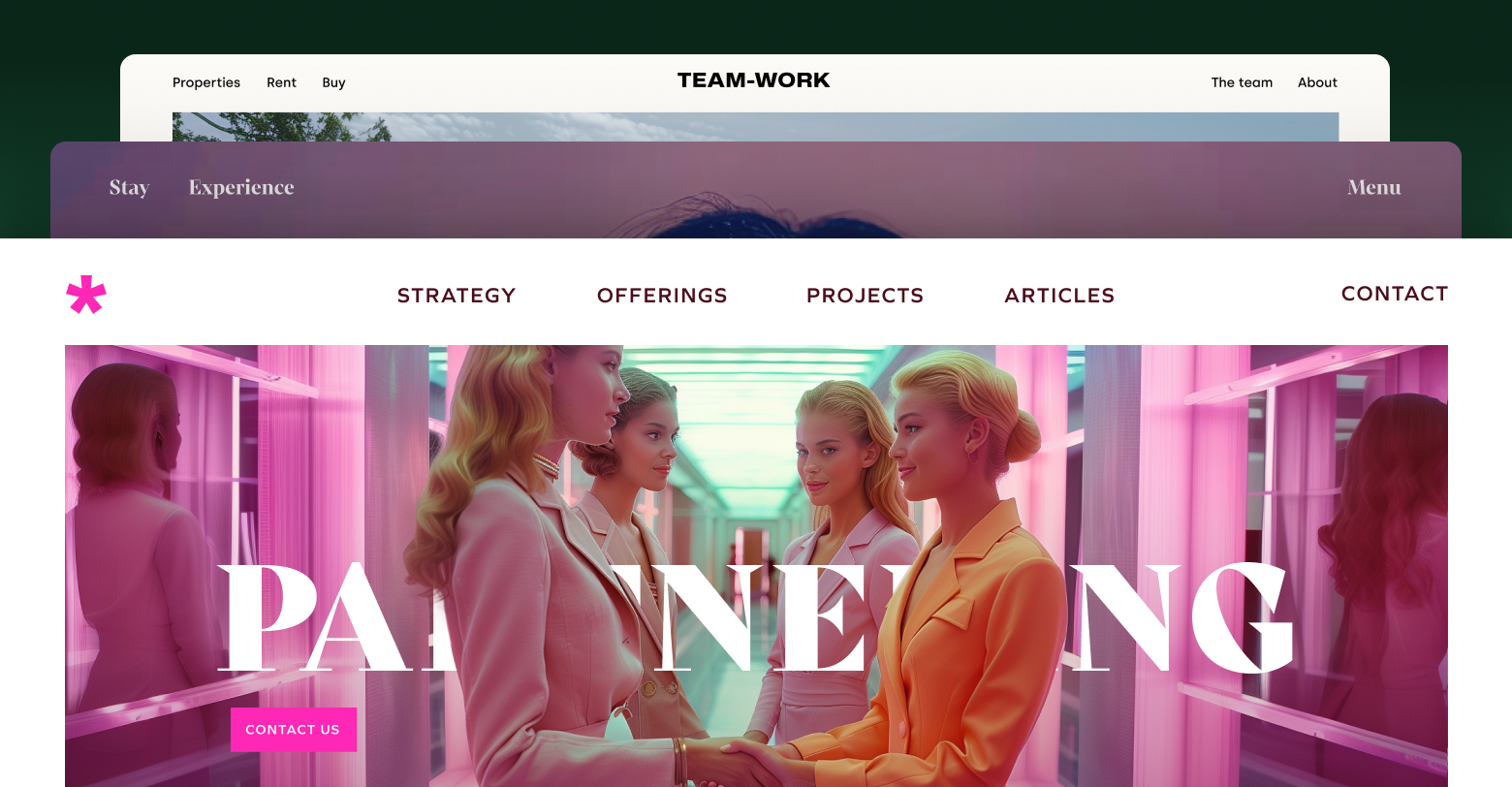When choosing a technology partner, the stakes are high. The right partner can elevate your business, enhance your offerings, and bolster your brand.
But the wrong partner can lead to a host of problems and risks for your business–from clunky integrations and frustrating user experiences to lack of ownership and control over your customer relationships. This is especially true when you're looking for a partner to offer websites to your clients or customers.
Here are 8 things to look for when selecting a technology partner (and how to avoid the most common pitfalls that cause tech partnerships to go south).
1. You retain ownership and control over your customer relationships
Almost unilaterally, the decision to white label or co-brand a website builder boils down to ownership and control.
Will I continue to own my customer relationships and customer experience? If not, how much control or influence do I have?
The same goes for other areas of a partner's business including its financials, marketing and promotion, and the product roadmap: What do I own or control? What can I influence?
The answers to these questions can make a huge difference to your business. Maintaining control and ownership of your customer experience and relationships can help you build and protect your brand, stay in control of your financial outcomes, drive your strategic goals, manage risk, and more.
The advantages of white labeling
At Duda, our approach has always been partner-first. That's by design! With Duda, you get a completely white labeled solution where you always own and control your entire customer experience and relationships from end to end.
- You own your customer experience:
After buying a website, your customer moves into a fully customized experience that puts your brand in the spotlight from end to end. You decide everything about their experience, and they never know it’s Duda under the hood.
- You own your commercials:
You own every aspect of your go-to-market, pricing strategy, and your margins. You don’t have to worry about competing with your partner’s retail pricing.
- You own your marketing & promotion: Inside the website editor and customer dashboard, you decide what messaging and promotions are served to your customers.
- You have influence over the product roadmap: In a great tech partnership, you have control of which features your clients or customers have access to, and you have influence over the product roadmap.
This is a very different approach than what you’ll find with other website builders that take a co-branded approach.
The drawbacks of co-branding
When you co-brand, you are giving up control and influence over key aspects in many different areas of your business:
- Your customer experience:
After buying a website, your customer moves into the website builder’s own editor and dashboard, co-branded with your business’s logo and color scheme. Beyond superficial branding elements, however, you have almost zero control of what your customer will experience in this environment.
- Commercials:
Many co-branded website builders structure their pricing in a revenue share model. The website builder also sets the retail price. When you as a co-branded partner are selling a standalone product, you have no influence over retail pricing, meaning you also have no control of your margins (beyond the cost of sales). Plus, you lose control over pricing and discounts being offered by the website builder. For example, if the website builder decides to run a 50% discount, this could conflict with your pricing strategy and revenue expectations.
- Marketing & promotion: Inside the website editor and customer dashboard all messaging and upsell motions are controlled by the website builder. As a co-branded partner, you can't determine and control when a customer is presented with an upsell and/or an add-on message.
- Product roadmap: Unlike Duda, most other website builders aren’t strictly focused on web professionals. They are also going to market direct-to-SMB and/or direct-to-individual. As a result, their product roadmap is locked down to outside influence (as you'd expect). This is a product of their business model, but it has real implications for their partners.
2. They take a partner-first approach
OK, so let’s dig in a bit more into what we mean by partner-first.
Partner-first means that your technology partner prioritizes your brand over their own. And a truly partner-first tech partner will never compete for your customers by putting their brand, logo, and marketing materials in front of your customers at every turn.
With a
white label website builder like Duda,
every aspect of the platform is fully under your organization’s brand–from the client login screen and editing dashboard to client support portal and email communications.
The end user has no knowledge of what’s powering their website under-the-hood, and you never have to worry about losing business to your website building partner.
From your customer’s perspective, they’re maintaining their website in your proprietary site builder. This helps reduce the risk of client churn, while putting your brand 100% in the spotlight.
Now let’s compare this to a co-branded solution.
Here’s how it goes: you’ve just offered your customer a shiny new website, you give them editing access, and just like that your customer’s inbox is flooded with the website builder’s promotional emails.
What’s stopping your customers from going direct with the website builder itself?
That’s not just a nagging voice in your head: it’s a legitimate concern. And it's why many agencies and SaaS platforms opt for a fully white label website builder over a co-branded solution.
3. They are established industry leaders
To get the best results, it’s important to partner with a company that is a leader in its field. Industry leaders are often more reliable, and their products are trusted and well-tested.
But don’t hyper-fixate on the biggest logos.
Lesser-known players might be lesser known for
exactly the reasons mentioned in the previous section:
they prioritize their partners’ brands over their own.
If you’re not sure where to start in your research, consider using tech marketplace tools like G2 to understand the players in the space, read user reviews, and find hidden gems.
For example, you may not have heard of Duda before
(not a huge surprise, considering that so much of what we do is behind the scenes!).
But if you take a look at the latest G2 grid for website builders, you’ll find that we’re rated #1 in customer satisfaction, and we’re the
highest-rated website builder overall with a score of 98/100.
4. They enable complete customization of the technology platform
Customization is another extremely important factor to consider in any tech partnership. Rather than forcing your business into rigid workflows and settings, customization flexibility lets you tailor the product to serve your market effectively. You know your customers best, so a flexible platform will give you full control to design your own user experience.
Curious why Duda has such high customer satisfaction?
One of the most important reasons is that we put your needs first by creating a platform that can be fully customized to meet your business needs and the needs of your customers. We work closely with you to define your goals, customize the platform to match your specific needs, and create exactly the customer experience you are envisioning.
You can also create your own product packaging, including choosing specific features and controls to match your customer base and go-to-market strategy.
5. The platform can be seamlessly integrated with your existing tools and offerings
For a partnership to be truly effective, it's essential that the technology integrates flawlessly with your existing offerings. This seamless integration ensures that the new technology enhances your current solution, fostering a positive user experience that not only attracts new business but also drives adoption and customer retention.
Just take a look at one of our recent success stories, CCC Intelligent Solutions.
“Integration was key,” said Ripul Jain, Director of Product at CCC, “The other website builders we talked to had all the parts, but the integration wasn’t there.”
With the Duda platform fully integrated into CCC’s technology, their customers can easily launch robust websites in as little as 10 minutes. Customers simply choose from a variety of pre-built, industry-specific templates that are dynamically populated using information from their existing CCC profile.
These websites have all the essential features built-in, including CCC’s tools for appointment scheduling, virtual estimates, and more. Plus, the end user experience is completely seamless. The customer feels like they’ve never left the CCC platform.
Read CCC’s story.
In another example, HR recruiting platform Shazamme used Duda’s white label website builder to deliver a seamless product with such an incredible customer experience that the company sees a 90% conversion rate from demo to paying customer.
6. They have a deep understanding of both your and your customers’ needs
Deep market knowledge is a critical component of a successful technology partnership. Choosing a partner with in-depth understanding of both your needs as a partner, and your end users’ needs, can significantly impact the effectiveness of the solutions provided.
This level of expertise ensures that the technological solutions are not only relevant but also proactive in addressing future industry developments, giving your business a competitive edge and helping you to anticipate market shifts before they happen.
Since its inception, Duda has been singularly focused on professional website builders serving SMBs. This focus has allowed us to refine and perfect tools that empower you to create cutting-edge websites that exceed your customers’ expectations - all at scale.
This deep commitment and longstanding specialization allows Duda to stay ahead of the curve, continuously integrating the latest trends and innovations in web design and functionality. Our proactive approach ensures that our partners always have access to the most advanced and effective tools and expertise available, helping them to deliver exceptional results to their SMB clients.
7. They provide both strategic and technical support
Look for a partner that offers comprehensive support both strategically and technically. This means they should not only be able to provide expert guidance on technical setup and ongoing optimization, but also provide strategic insights on how to effectively use their technology to grow your business.
At Duda, our dedicated account management team does just that, acting as a trusted advisor at every stage of the process–from strategy and technical setup to ongoing optimization.
In addition, Duda’s customer service team is a 3-time
Stevie Award Winner. Most recently, the team was recognized as a Silver winner in the categories of customer service automation and innovation, highlighting our commitment to pushing the envelope to deliver best-in-class customer experiences.
8. They offer you a seat at the table, including collaboration on roadmap definition
Finally, a strong partner will collaborate with you in defining the product roadmap, taking into account your feedback and future needs. This collaborative approach ensures that the product evolves in a way that benefits both parties and meets the changing demands of your customers.
That’s one of the most unique aspects of working with Duda – we’re not just providing a solution. We’re working in lockstep with our partners to build better and better products.
We think that’s pretty exciting, and so do our partners!
Just ask Ricarda Kies, CEO and Co-Founder of LODGEA, a leading direct booking and website building platform for travel and hospitality.
“Duda is groundbreaking for us,” said Kies, “With Duda, we are able to grow together to build an even better solution. It’s a lot more than just a technical partnership.”
Read LODGEA’s story.
Get in touch to learn more about partnering with Duda.







